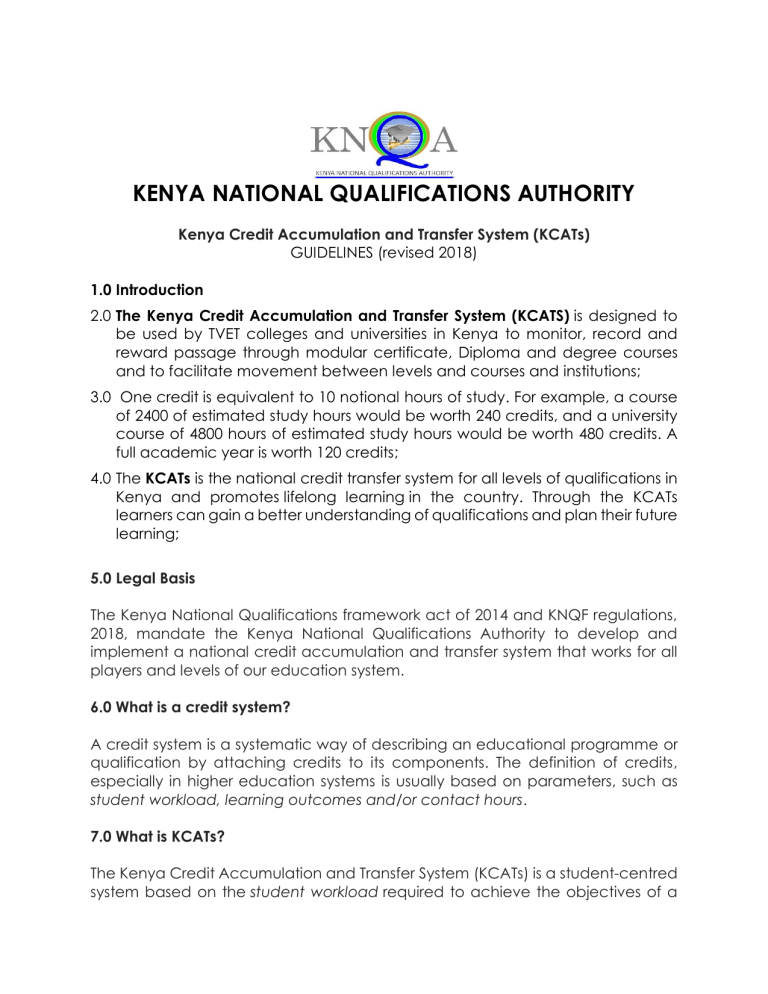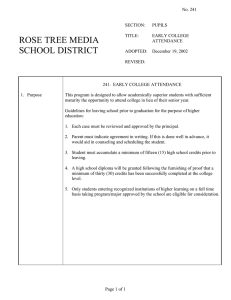
KENYA NATIONAL QUALIFICATIONS AUTHORITY Kenya Credit Accumulation and Transfer System (KCATs) GUIDELINES (revised 2018) 1.0 Introduction 2.0 The Kenya Credit Accumulation and Transfer System (KCATS) is designed to be used by TVET colleges and universities in Kenya to monitor, record and reward passage through modular certificate, Diploma and degree courses and to facilitate movement between levels and courses and institutions; 3.0 One credit is equivalent to 10 notional hours of study. For example, a course of 2400 of estimated study hours would be worth 240 credits, and a university course of 4800 hours of estimated study hours would be worth 480 credits. A full academic year is worth 120 credits; 4.0 The KCATs is the national credit transfer system for all levels of qualifications in Kenya and promotes lifelong learning in the country. Through the KCATs learners can gain a better understanding of qualifications and plan their future learning; 5.0 Legal Basis The Kenya National Qualifications framework act of 2014 and KNQF regulations, 2018, mandate the Kenya National Qualifications Authority to develop and implement a national credit accumulation and transfer system that works for all players and levels of our education system. 6.0 What is a credit system? A credit system is a systematic way of describing an educational programme or qualification by attaching credits to its components. The definition of credits, especially in higher education systems is usually based on parameters, such as student workload, learning outcomes and/or contact hours. 7.0 What is KCATs? The Kenya Credit Accumulation and Transfer System (KCATs) is a student-centred system based on the student workload required to achieve the objectives of a programme and/or qualification objectives preferably specified in terms of learning outcomes and competences to be acquired. 8.0 Development of the KCATs system KCATs was introduced in 2018, within the KNQF, as a way of harmonizing education and training at different levels in the country; and for improving student mobility across different levels and institutions of learning. The system is currently being tested in Kenya; with plans to extend it to the East African region. The system facilitates the recognition of periods of study abroad and thus enhances the quality and volume of student mobility in East Africa. The system is designed to develop into an accumulation system to be implemented at institutional, national and Regional level. 9.0 Why introduce KCATs? KCATs makes study programmes easy to read and compare for all students, lecturers and institutions. KCATs facilitates mobility and academic recognition. KCATs helps colleges and universities to organize and revise their study programmes and/or qualifications. KCATs can be used across a variety of programmes and modes of delivery. KCATs makes Kenyan higher education more attractive for students from other countries. 10.0 What are the key features of KCATs? i. ii. iii. KCATs is based on the convention that 120 credits measure the workload of a full-time student during one academic year. The student workload of a fulltime study programme in Kenya amounts in most cases to 36/40 weeks per (academic) year and in those cases one credit stands for 10 notional hours. Workload refers to the notional time an average learner might expect to complete the required learning outcomes. Credit is also a way of quantifying the outcomes of learning. Learning outcomes are sets of competences, expressing what the student will know, understand or be able to do after completion of a process of learning. Credits in KCATs can only be obtained after completion of the work required and appropriate assessment of the learning outcomes achieved. The allocation of KCATs credits is based on the official length of a study programme cycle. The total workload necessary to obtain an artisan certificate is 6 months (or 60 credits), Craft Certificate is one year (120 credits), Diploma is 2 to 3 years (240 to 360 Credits), Bachelor’s degree lasting officially four to six years is expressed as 480 to 700 credits; master’s Degree will take 2 years (240 credits), postgraduate diploma (one year or 120 credits); and doctorate (3 years or 360 credits); iv. v. vi. Student workload in KCATs includes the time spent in attending lectures, seminars, independent study, preparation for, and taking of, examinations, practical work, field study, field attachment, internship, teaching practice etc. Credits are allocated to all educational components of a study programme (such as modules, courses, placements, dissertation work, etc.) and reflect the quantity of work each component requires in relation to the total quantity of work necessary to complete a full year of study in the programme considered. The performance of the student is documented by institutional/national grade. The KCATs grading scale ranks the students on a statistical basis. Therefore, statistical data on student performance is a prerequisite for applying the KCATS grading system. Grades are assigned among students with a pass grade as follows: a. b. c. d. e. vii. Marks 70% and above 60-69% 50-59% 40-49 % Less than 40 Grade A B C D Fail GPA 4 3 2 1 Degrees and Diplomas will be classified as follows; The degrees and Diplomas shall be classified as follows, using the overall average mark Average Mark 70% and above 60% - below 70% 50% - below 60% 40% - below 50% Below 40% Fail Degree Classification Diploma/Cert Classification First Class Honours Distinction Second Class (Upper D) Upper Credit Second Class (Lower D) Lower Credit Pass Pass 11. 0 Requirements for Credit Transfer; a. No credit shall be transferred for core courses of a program; b. No more than 49% of credits shall be transferred from one level to another; c. Credits shall only be transferred from courses that were taken within the last four years; d. Students who get an average of a distinction at certificate level (or took a certificate program that lasted for two years or more); shall be allowed to join Diploma programs at year two (if credits transferred are not more than 49% of the Diploma program); All other students will join Diploma programs at year one; e. Students who took a Diploma program that lasted for three years or more shall be allowed to join Degree programs at year three, if they get a Credit and above (if credits transferred are not more than 49% of the Degree program enrolled in); Those getting lower than a credit shall enroll in year 2 of the Degree program; f. Students who get an average of a Credit at two-year Diploma programs shall be allowed to join Degree programs at year two (if credits transferred are not more than 49% of the Degree program enrolled in); All other two-year Diploma students will join Degree programs at year one; g. Students who have taken more than two semesters of study for a Bachelor’s degree at one university can transfer all credits to a related bachelor’s degree at another university; h. Students who have taken more than two semesters of study for a master’s degree at one university can transfer all credits to a related (see KNQF organizing fields for guidance) master’s degree at another university; subject to an acceptable status report from his/her previous supervisors and approval by the receiving university’s graduate school; i. Students who have taken more than two semesters of study for a doctoral degree at one university can transfer all credits to a related (see KNQF organizing fields for guidance) doctoral degree at another university; subject to an acceptable status report from his/her previous supervisors and approval by the receiving university’s graduate school; 15. Program classification The table below shows the classification table that will be used to equate related programs at different universities. Stakeholders in each program discipline will strive to map all the recognized certificates, Diplomas and Degrees in the discipline and create a suitable detailed CATs, procedures for application and related matters. The CATs once developed will be Approved by the KNQA for use by all training institutions that apply to join and use the program for specified programs/qualifications. 1. 2. 3. 4. 5. 6. 7. 8. PROGRAMMES GROUPS Law & Related Business & Related Arts & Related GeoScience & Related Special Education Kiswahili & Related Engineering, Technology & Related Architecture, Design, Planning & Related 9. 10. 11. 12. 13. 14. 15. 16. 17. 18. 19. 20. 21. 22. 23. Computing, IT & Related Agribusiness & Related Science & Related Mathematics, Economics & Related Design, Textiles & Related Sports, Physical Education & Related Medicine, Nursing, Health & Related History & Related Agriculture, Food Science, Environment & Related Geography, Natural Resources Management & Related French & Related German & Related Music & Related Education Science & Education Arts Religious Studies & Related 16.0 Who Can Participate All Institutions awarding qualifications can apply to use the KCATs and specify programs that they want to enlist in the system. Institutions will be required to pay a fee of ksh 10,000 per instution and ksh 5,000 per program to participate in the system for a 4-year period; that can be renewed on request. KNQA is working with the Kenya Universities and Colleges Central Placements services (KUCCPS) to use programs enlisted in the system to admit students. 17.0 What are the key documents of KCATs? i. ii. iii. The registered institutions in the system shall produce and distribute a catalogue of programs registered in the KCATs system and requirements for enrollment and participation; Each Institution shall produce a Learning Agreement that contains the list of courses to be taken; and agreed upon by the student and the institution concerned. The Learning Agreement must be agreed upon by the student and the two institutions concerned before the student’s departure and to be updated immediately when changes occur; The Transcript of performance of a student which shows the list of courses taken, the credits gained and possibly KCATs grades awarded. In case of credit transfer, the Transcript of Records must be issued by the home institution for outgoing students before departure and by the host institution for incoming students at the end of their period of study. 18.0 How to obtain the KCATs Label? i. An KCATs label will be awarded to institutions, which apply KCATs in the proper way in all their programmes. The label will raise the profile of the institution as a transparent and reliable partner in Kenya and the region. ii. The criteria for the label will be: A Course Catalogue (online or hard copy) in English (for programmes taught in English), use of KCATs credits, samples of learning Agreements and Transcripts of Records. iii. An application form allowing students to participate in KCATs will be published on the web site of the Kenya National Qualifications Authority (KNQA). iv. The label will be valid for four academic years, starting 2019/2020. The list of institutions in possession of the label will be published on the KNQA web site. 18.0 Where to find more information on KCATs? More information on KCATs can be found on the KNQA web site For More details Contact The Director General/CEO Kenya National Qualifications Authority 6th Floor, Uchumi Hse Po Box 72635-00200 Nairobi, Kenya Email: knqa.go.ke@gmail.com www.knqa.go.ke
